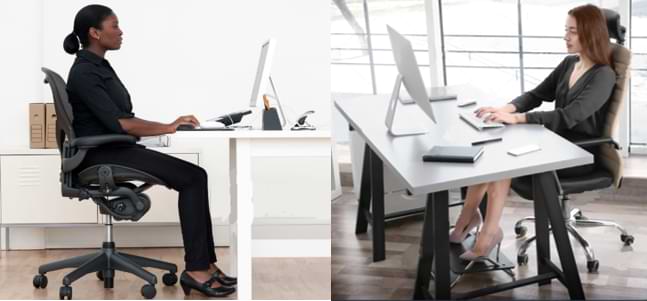HOW DOES POOR POSTURE STUNT YOUR BODY AND REDUCE HEIGHT ?
Bad posture affects or reduces height in a number of ways so, fixing it is very critical.
The ways we position our bodies especially while sitting, walking, sleeping or standing can have a tremendous impact on how tall our bodies appear.
Hence, poor posture is one of the external or environmental factors that can make you have a short stature.
However, changing or correcting your posture may not be as easy as it may sound since some of these poor postural habits are programmed in our minds or simply because we choose to sit a certain way because that’s what makes us feel comfortable.
For instance, if you’ve been walking, sleeping or sitting a certain position since child hood, or for some time, without being aware that it affects your body height, you don’t expect to change that habit in an instant.
It will take time and effort to break that habit.
Factors that lead to poor posture
1. Stress
The state of your mind or your emotions can be reflected in your body posture.
Conversely, your body posture can affect your mood and increase stress levels.
Studies demonstrate that a number of your day to day body postures are a function of your emotions like; admiration, disgust, confusion, interest, adoration, aesthetic, fear, appreciation, entrancement, amusement, anger, joy, anxiety, sexual desire, awe, awkwardness, boredom, calmness, excitement, craving, nostalgia, empathic pain, horror, relief, romance, surprise, sadness, satisfaction.
The changes in body posture may occur at a subconscious level without you even being aware.
For instance, when you are in a feel good mood and confident about your self, your spine will be properly aligned and head above your shoulders yet when you are sad, frustrated, disappointed, worried or even tired, your shoulders and head may drop.
On the other hand, the way we sit or stand can affect our mood or the way we feel emotionally.
For instance, in an experiment that aimed to asses the effect of upright seated position on psychological stress, subjects who assumed the upright seated position alleged they were more aroused, had less fear, higher self esteem and were in a much better mood compared to their slumped seated counterparts.
Thus, it’s advised to maintain an upright seated posture during stressful times to maintain a high self esteem and positive mood.
2. Body weight
A high body mass index affects your core stability in one way or the other which in turn affects the body’s ability to control the upper body or torso in case of internal or external influences.
It’s a fact that in most obese people, the fat tissue accumulates around the abdominal area and some of this fat penetrates the abdominal muscles.
This renders the abdominal muscles weaker and less effective in maintaining or controlling the spine alignment when standing thus leading to poor standing posture among overweight individuals.
Core stability in the abdominal or pelvic areas is very critical for body posture [1].
3. Foot wear
Many studies have established a connection between wearing high heeled shoes to changes in body posture among women.
High heeled shoes affect the natural alignment of the spine when person is standing due to shifts in the center of gravity.
The body assumes its normal position once the high heeled shoes are removed but according to studies, consistent or overusing such shoes, results into permanent changes in body posture.

4. Poor sitting, standing and sleeping habits.
Ensuring that you maintain the correct posture during these three activities is an important step to maintaining proper body alignment.
These are the biggest culprits of poor posture since we spend most of the time either sleeping, sitting or even standing. More about this is discussed later in the article.
Below are the different ways poor posture can affect or reduce height and the measures to take to correct it.
1. Sitting
Maintaining correct sitting posture is extremely important because the strain on the back is greater in a sitting position than it is in a standing or lying down position.
According to research literature, the amount of pressure exerted on the spinal disc when seated is roughly twice the pressure while in standing position.
Thus, adopting a poor sitting posture for a long time will terribly affect the spine.
That’s partly the reason why up to over 50% of folks who work in offices report pain in the lower back.
Working with a computer requires maintaining a seated posture for a long time, and therefore, it is very difficult to maintain correct posture.
Like earlier mentioned, we tend to sit a certain way because of the ingrained habits.
And when the bad posture becomes habit at an early age, we deem it comfortable.
we maintain the bad posture even when we realize that we are assuming the wrong posture and even when we desire to correct it.
This in turn increases pressure on the spinal discs, pelvis joints , and muscles thus leading to fatigue and misaligned bodies that make us look a couple of inches shorter. [2]
Poor sitting Postures

Appropriate sitting Posture.
Appropriate sitting posture involves keeping the feet flat on the floor, head aligned above shoulders, and lower back supported.
If your seat doesn’t have the provision to support your lower back, then use a cushion to support the lower back and make sure to press your bottom against the chair.
Without the lower back support, the pressure on your lower back increases which compresses the lumbar or lower back spinal discs leading to not only losing some height but also lower back pain problems.
Slouching or sitting in a slouched positing (Leaning forward or back ward while seated) also increases pressure on lower back.

Recommendations;
Even with the appropriate sitting posture, staying seated in the same position for long hours will have a negative impact on your spine or back.
It’s recommended to change sitting positions every 30 or so minutes and to take breaks from sitting by moving around or stretching your spine.
2. Sleeping
We spend plenty of time in the sleeping position so making sure that we adopt the right sleeping posture is critical for spine health.
Sleeping on your stomach
It’s generally not recommended to sleep on our stomach because the lower back will over arch which puts the spine out of alignment.
This in turn increases the pressure on neck and lower back discs which may not only lead to disc compression, but also lead to other complications like back and neck pain.
If you must sleep on your stomach because that’s what makes you feel comfortable, it’s advised to place a cushion under your belly to keep the spine aligned.

If you sleep on your side, Just place a pillow between your knees and below your head.
Placing a pillow between your knees helps to support your lower back which will prevent lower back disc compression there by preventing you from losing height.

3. Standing
Standing straight and tall not only makes you appear taller, it exudes confidence.
To stand tall while maintaining the correct posture, stand at ease with your feet placed approximately as wide as your shoulders.
Keep the head straight above your shoulders, in the middle with the chest out wide.
If the hands are free, then let your arms hang freely.
If you are standing for long hours, the stand on one leg at a time while relaxing the other leg.
AUTHOR BIO
As a short guy who was psychologically distressed almost everyday due to the challenges he faced in life accountable to his height, Dennis Raney (Bsc.) finally somehow found a way to overcome this adversity by naturally increasing his height with lifestyle and healthy changes.
He has been researching this topic for over a decade and practically applying the knowledge so he decided to share his wealth of information about the topic of increasing height both during and after puberty in the book and on this blog.
Feel free to connect with him for a conversation:
Email: Dennis »»
Facebook: Connect »»
NEXT : how to grow taller after puberty complete guide.


